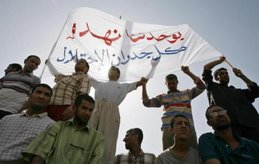Huge rise in birth defects in Falluja
Martin Chulov in Falluja
Huge rise in birth defects in Falluja
Iraqi former battle zone sees abnormal clusters of infant tumours and deformities
- guardian.co.uk, Friday 13 November 2009 19.24 GMT
- Article history
Doctors in Iraq's war-ravaged enclave of Falluja are dealing with up to 15 times as many chronic deformities in infants and a spike in early life cancers that may be linked to toxic materials left over from the fighting.
The extraordinary rise in birth defects has crystallised over recent months as specialists working in Falluja's over-stretched health system have started compiling detailed clinical records of all babies born.
Neurologists and obstetricians in the city interviewed by the Guardian say the rise in birth defects – which include a baby born with two heads, babies with multiple tumours, and others with nervous system problems - are unprecedented and at present unexplainable.
A group of Iraqi and British officials, including the former Iraqi minister for women's affairs, Dr Nawal Majeed a-Sammarai, and the British doctors David Halpin and Chris Burns-Cox, have petitioned the UN general assembly to ask that an independent committee fully investigate the defects and help clean up toxic materials left over decades of war – including the six years since Saddam Hussein was ousted.
"We are seeing a very significant increase in central nervous system anomalies," said Falluja general hospital's director and senior specialist, Dr Ayman Qais. "Before 2003 [the start of the war] I was seeing sporadic numbers of deformities in babies. Now the frequency of deformities has increased dramatically."
The rise in frequency is stark – from two admissions a fortnight a year ago to two a day now. "Most are in the head and spinal cord, but there are also many deficiencies in lower limbs," he said. "There is also a very marked increase in the number of cases of less than two years [old] with brain tumours. This is now a focus area of multiple tumours."
After several years of speculation and anecdotal evidence, a picture of a highly disturbing phenomenon in one of Iraq's most battered areas has now taken shape. Previously all miscarried babies, including those with birth defects or infants who were not given ongoing care, were not listed as abnormal cases.
The Guardian asked a paediatrician, Samira Abdul Ghani, to keep precise records over a three-week period. Her records reveal that 37 babies with anomalies, many of them neural tube defects, were born during that period at Falluja general hospital alone.
Dr Bassam Allah, the head of the hospital's children's ward, this week urged international experts to take soil samples across Falluja and for scientists to mount an investigation into the causes of so many ailments, most of which he said had been "acquired" by mothers before or during pregnancy.
Other health officials are also starting to focus on possible reasons, chief among them potential chemical or radiation poisonings. Abnormal clusters of infant tumours have also been repeatedly cited in Basra and Najaf – areas that have in the past also been intense battle zones where modern munitions have been heavily used.
Falluja's frontline doctors are reluctant to draw a direct link with the fighting. They instead cite multiple factors that could be contributors.
"These include air pollution, radiation, chemicals, drug use during pregnancy, malnutrition, or the psychological status of the mother," said Dr Qais. "We simply don't have the answers yet."
The anomalies are evident all through Falluja's newly opened general hospital and in centres for disabled people across the city. On 2 November alone, there were four cases of neuro-tube defects in the neo-natal ward and several more were in the intensive care ward and an outpatient clinic.
Falluja was the scene of the only two setpiece battles that followed the US-led invasion. Twice in 2004, US marines and infantry units were engaged in heavy fighting with Sunni militia groups who had aligned with former Ba'athists and Iraqi army elements.
The first battle was fought to find those responsible for the deaths of four Blackwater private security contractors working for the US. The city was bombarded heavily by American artillery and fighter jets. Controversial weaponry was used, including white phosphorus, which the US government admitted deploying.
Statistics on infant tumours are not considered as reliable as new data about nervous system anomalies, which are usually evident immediately after birth. Dr Abdul Wahid Salah, a neurosurgeon, said: "With neuro-tube defects, their heads are often larger than normal, they can have deficiencies in hearts and eyes and their lower limbs are often listless. There has been no orderly registration here in the period after the war and we have suffered from that. But [in relation to the rise in tumours] I can say with certainty that we have noticed a sharp rise in malignancy of the blood and this is not a congenital anomaly – it is an acquired disease."
Despite fully funding the construction of the new hospital, a well-equipped facility that opened in August, Iraq's health ministry remains largely disfunctional and unable to co-ordinate a response to the city's pressing needs.
The government's lack of capacity has led Falluja officials, who have historically been wary of foreign intervention, to ask for help from the international community. "Even in the scientific field, there has been a reluctance to reach out to the exterior countries," said Dr Salah. "But we have passed that point now. I am doing multiple surgeries every day. I have one assistant and I am obliged to do everything myself."
Additional reporting: Enas Ibrahim.









